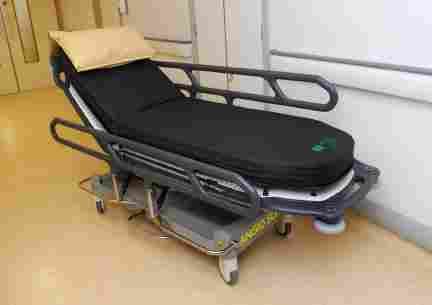The study, led by Dr Arthur Tucker, principal clinical scientist at Barts and The London NHS Trust, found that up to a third of the weight of a pillow could be made up of bugs, dead skin, dust mites and their faeces. This makes them ideal breeding grounds for healthcare associated infections, with up to 30 bugs found living in a single pillow.
People put a clean pillow case on and it looks and smells nice and fresh, but you are wrapping up something really nasty underneath
Most of them are found on the outside of the pillows, but where rips and tears are present, the research found the bugs made their way into the filling. Some of the bedding tested was found to be contaminated with the E.coli stomach bug and others harboured germs that could cause serious infections; a major problem in the sick and particularly those with lowered immunity.
In the report, which has not yet been made public, hospital-issue pillows had more than one million Staphylococcus hominus bugs, which can cause severe infections, per milliliter. Dr Tucker describes the level as a 'biohazard', adding: "The presence of these bugs means they will be passed onto patients."
The study goes on to compare the prevalence of bugs on and inside standard hospital pillows with those found in anti-bacterial versions. Using SleepAngel pillows manufactured by Irish firm, Gabriel Scientific, the research found they were less likely to be contaminated on the outside and all tested negative for germs inside.
Duncan Brain, technical director of Gabriel Scientific, said: "If you had to come up with a medium to cultivate bacteria, besides a Petri dish with agar, a pillow is pretty much as good as you can get. It is a wet sponge that absorbs bodily fluids of various kinds providing nutrients and it is kept at the idea temperature by the warm body lying on top of it."
Dr Tucker added: "People put a clean pillow case on and it looks and smells nice and fresh, but you are wrapping up something really nasty underneath."
Hospitals trusts and other inpatient environments and care homes have policies for the decontamination of beds and bedding, including pillows, but this is mainly as part of a standard approach to cleaning and is usually only carried out between patients, or if the pillow is seen to be damaged.
A report by South Tees Hospitals NHS Foundation Trust states: "The interior filling for pillows and duvets is an efficient incubator of micro-organisms if contamination occurs. Bedding material may become colonised with bacteria and become a reservoir of infection.
"All pillows and duvets used within the hospital setting should be made from a polyurethane-coated fabric with welded seams. Pillows and duvets should be routinely wiped clean between patients with hot water and detergent. If surface contamination with blood occurs, it should be cleaned with hypochlorite 10,000 ppm in a detergent solution. Pillows and duvets are NOTto go into the trust laundry system, but to be cleaned on the ward or department. In the event of the outer cover becoming damaged, the item should be discarded as domestic waste. However, if the pillow is contaminated with blood or other body fluids, it must be discarded as clinical waste."
NHS Plymouth's Decontamination Guidelines and Procedures (Cleaning and Disinfectant) document, published in February this year, state: "Beds should be washed down with detergent and water and dried between patients. This includes the mattress, pillows, bedhead and cot sides. It is important to ensure the mattress and pillows are dried to prevent material deterioration.
"All pillows, mattresses and duvets should have plastic covers. Check that the cover is intact and, if damaged, check the condition of pillow, duvets or mattress. If visibly clean, apply new cover. If soiled, dispose of according to waste policy. Clean intact covers with detergent and hot water or detergent wipe and dry well."
And at Heatherwood and Wexham Park Hospitals NHS Foundation Trust, a report on reducing Staphylococcus aureus in adult surgical and medical departments states: "General hospital mattresses and pillows must be cleaned using general-purpose detergent followed by disinfection 0.1% Chlorine solution, not alcohol. Waterproof pillows should be checked for permeability and tears and condemned if damaged."
Official World Health Organization (WHO) guidelines state that pillows should be cleaned with detergent and water between patients, adding that any contaminated bedding must be discarded and torn covers replaced.
If you had to come up with a medium to cultivate bacteria, besides a Petri dish with agar, a pillow is pretty much as good as you can get
To address the issue there are now a number of infection control pillows on the market, including SleepAngel, which uses a PneumaPure filter device integrated within the cover of the product. This provides a physical barrier that lets the product 'breathe', but stops pathogens entering.
Ian Bolton, a senior cardiac physiologist and infection prevention link practitioner at Broomfield Hospital in Essex, has also designed The Bolton Pillow Case, which has a surface that be cleaned in seconds with an antibacterial wipe, eliminating the need for a conventional pillowcase. It is aimed at cardiac departments, ultrasound units, clinical rooms, A and E, care homes and a wide range of outpatient settings.

Designed with the help of Health Enterprise East, the NHS innovation hub for the East of England, it is already in use in the UK. Bolton said: "Made from the same materials as a conventional clinic couch, it has a flap of material along its top edge, which hangs over the top of a couch backrest. Along the far edge of the flap is a row of discreet counter balance weights which stop the pillow from sliding down the backrest. This means it can be put into position in around two seconds without any fixings and, very importantly, it stays in place which is more comfortable for the patient."
